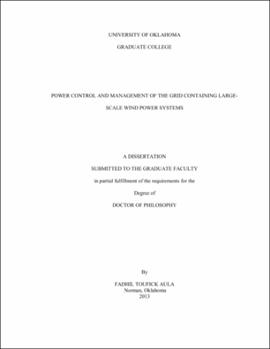| dc.contributor.advisor | Lee, Samuel C | |
| dc.creator | Aula, Fadhil T. | |
| dc.date.accessioned | 2019-04-27T21:29:14Z | |
| dc.date.available | 2019-04-27T21:29:14Z | |
| dc.date.issued | 2013 | |
| dc.identifier | 99226172402042 | |
| dc.identifier.uri | https://hdl.handle.net/11244/318798 | |
| dc.description.abstract | The ever increasing demand for electricity has driven many countries toward the installation of new generation facilities. However, concerns such as environmental pollution and global warming issues, clean energy sources, high costs associated with installation of new conventional power plants, and fossil fuels depletion have created many interests in finding alternatives to conventional fossil fuels for generating electricity. Wind energy is one of the most rapidly growing renewable power sources and wind power generations have been increasingly demanded as an alternative to the conventional fossil fuels. However, wind power fluctuates due to variation of wind speed. Therefore, large-scale integration of wind energy conversion systems is a threat to the stability and reliability of utility grids containing these systems. They disturb the balance between power generation and consumption, affect the quality of the electricity, and complicate load sharing and load distribution managing and planning. Overall, wind power systems do not help in providing any services such as operating and regulating reserves to the power grid. | |
| dc.description.abstract | In order to resolve these issues, research has been conducted in utilizing weather forecasting data to improve the performance of the wind power system, reduce the influence of the fluctuations, and plan power management of the grid containing large-scale wind power systems which consist of doubly-fed induction generator based energy conversion system. The aims of this research, my dissertation, are to provide new methods for: smoothing the output power of the wind power systems and reducing the influence of their fluctuations, power managing and planning of a grid containing these systems and other conventional power plants, and providing a new structure of implementing of latest microprocessor technology for controlling and managing the operation of the wind power system. | |
| dc.description.abstract | In this research, in order to reduce and smooth the fluctuations, two methods are presented. The first method is based on a de-loaded technique while the other method is based on utilizing multiple storage facilities. The de-loaded technique is based on characteristics of the power of a wind turbine and estimation of the generated power according to weather forecasting data. The technique provides a reference power by which the wind power system will operate and generate a smooth power. In contrast, utilizing storage facilities will allow the wind power system to operate at its maximum tracking power points' strategy. Two types of energy storages are considered in this research, battery energy storage system (BESS) and pumped-hydropower storage system (PHSS), to suppress the output fluctuations and to support the wind power system to follow the system load demands. Furthermore, this method provides the ability to store energy when there is a surplus of the generated power and to reuse it when there is a shortage of power generation from wind power systems. Both methods are new in terms of utilizing of the techniques and wind speed data. | |
| dc.description.abstract | A microprocessor embedded system using an Intel® Atom<sup>TM</sup> processor is presented for controlling the wind power system and for providing the remote communication for enhancing the operation of the individual wind power system in a wind farm. The embedded system helps the wind power system to respond and to follow the commands of the central control of the power system. Moreover, it enhances the performance of the wind power system through self-managing, self-functioning, and self-correcting. | |
| dc.description.abstract | Finally, a method of system power management and planning is modeled and studied for a grid containing large-scale wind power systems. The method is based on a new technique through constructing a new load demand curve (NLDC) from merging the estimation of generated power from wind power systems and forecasting of the load. | |
| dc.description.abstract | To summarize, the methods and their results presented in this dissertation, enhance the operation of the large-scale wind power systems and reduce their drawbacks on the operation of the power grid. | |
| dc.format.extent | 140 pages | |
| dc.format.medium | application.pdf | |
| dc.language | en_US | |
| dc.relation.requires | Adobe Acrobat Reader | |
| dc.subject | Wind energy conversion systems--Design and construction | |
| dc.subject | Wind power industry | |
| dc.title | POWER CONTROL AND MANAGEMENT OF THE GRID CONTAINING LARGE-SCALE WIND POWER SYSTEMS | |
| dc.type | text | |
| dc.type | document | |
| dc.thesis.degree | Ph.D. | |
| ou.group | College of Engineering::School of Electrical and Computer Engineering | |
